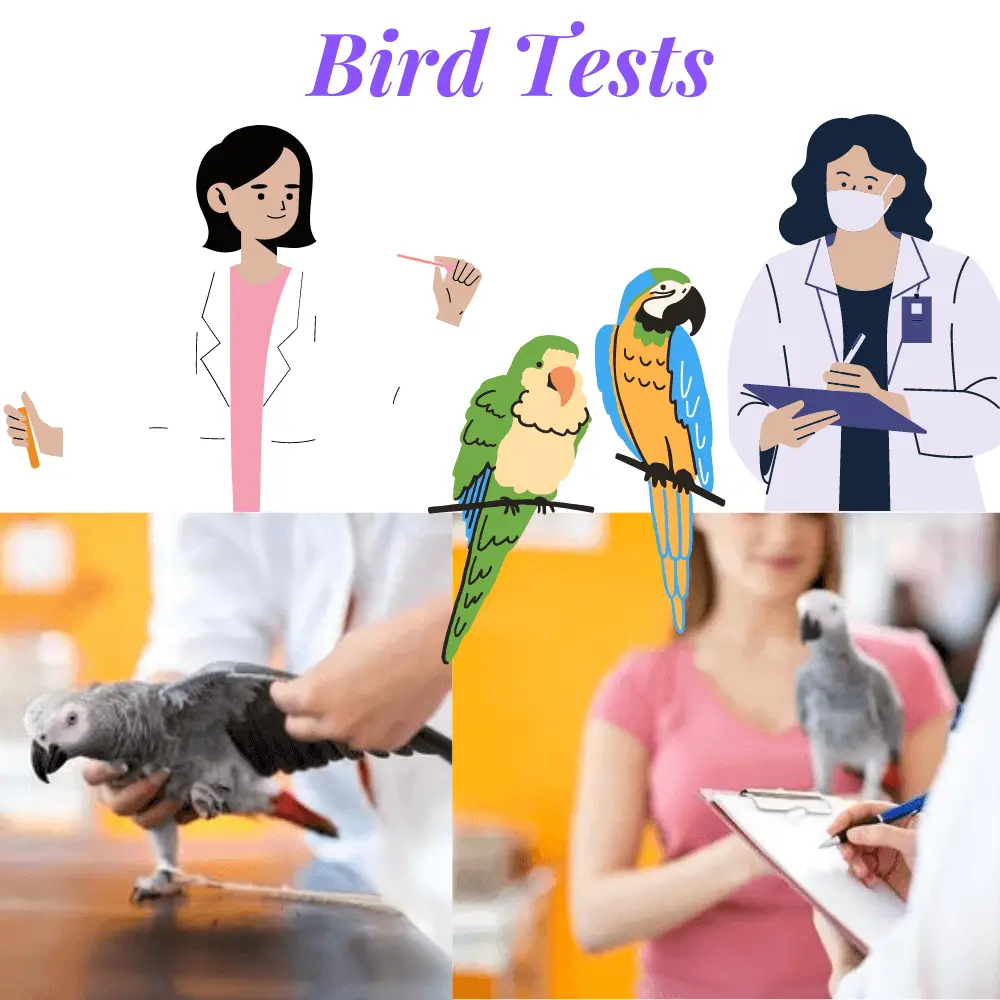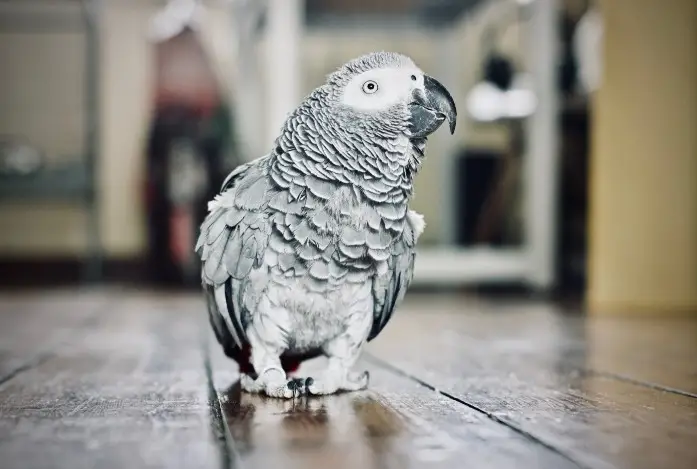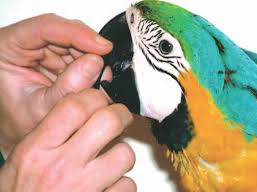
bird tests and Screening tests for parrots As we will detail in Part IV of this work, there are some diseases that can be fatal to the bird. Often, it contracts the germ inbreeding where the infectious pressure is more important.
The owner, therefore, risks “buying the disease” at the same time as his companion. This may have serious consequences for the purchaser, whether financial (treatment, veterinary fees, etc.) or sanitary (contamination of his farm, etc.). In addition, some of these pathogens (Chlamydophila Psittacidae for example) are serious zoonotic agents (see Part IV-E).
It is therefore advisable to ask the breeder to carry out certain tests before the sale.
Parrot tests

Screening tests for parrots
Commonly sought diseases are:
- Beak and feather disease (circovirus): PCR viral DNA testing.
- Proven virus dilatation disease (bornavirosis): detection of viral DNA by PCR or antibody detection by serology (ELISA) (GANCZ, CLUBB, SHIVAPRASAD 2010).
- Chlamydophilosis (Chlamydophila Psittacidae): search for bacterial DNA by PCR (PANTCHEV et al., 2009).
- Pacheco (herpesvirus): research of viral DNA by PCR (WELLEHAN et al., 2009).

The choice of a parrot is, therefore, an act that is reflected well in advance and to which the owner and the veterinarian who advises it must give great importance
The tests to be done The “4 diseases” Chlamydophilosis (or psittacosis)-PBFD-Pacheco disease-Polyomavirus
Other tests exist apart from the “4 diseases”. It is possible to do stool smears, choanas, x-rays, blood biochemistry, etc. All the other tests can also provide useful data on the health of your new bird. Without being essential, certain tests (eg smear) give a lot of information and are inexpensive. They can be useful on a first visit. Discuss this with your veterinarian.

Screening tests for parrots
Approximate costs
Usually, the bird must be examined before it can be tested. The exam is also very important in itself! In Quebec, test prices range from $ 156 to $ 430. Exam prices range from $ 40 to $ 70. More sometimes a file opening ($ 7-15).
The most diagnosed disease in Quebec is Chlamydiophilosis (in about 1% of cases according to my house survey) followed by PBFD (much rarer).
Frequency
A new bird should ALWAYS be tested! Especially if you have children or are in contact with the elderly or immunocompromised people (watch out for psittacosis which is transmissible to humans!). This is a responsibility you have for your health, that of other humans and other birds!
The frequency of the tests to be done depends on the risks to which your birds are exposed. The tests are “valid” until the bird has been in contact with pathogens.
If you never see a bird, don’t go to pet stores, and don’t have friends with birds, the chances of carrying a pathogen home are very slim.
If your bird is in contact with other birds if you go to the veterinarian, pet stores for the size of claws, buy toys in pet stores, the risks are higher.
The frequency of the tests is at your discretion, but a bird that is more “at-risk” can possibly be tested each year if you see fit. This can be a reminder every 2 years, 5 years …
Before entering a new bird, it is always useful to double-check the status of your bird to be sure not to contaminate your new bird!
How’s it going
Detection tests are DNA tests by PCR (polymerase chain reaction).
The veterinarian should take a blood sample (usually in the jugular vein or metatarsal vein of the paw, methods of taking blood in the wing or claw are less recommended).
Sometimes, depending on the laboratories performing the tests, the veterinarian may also take a smear (with a cotton swab) of the choanas (at the palate) and the cloaca (anus) of the bird. There are usually no additional costs from the laboratory and the results are more reliable! Ask your veterinarian if it is possible with the laboratory where he does business.
These are very precise but not absolute tests. There are “false negatives” and “false positives”. If a test comes back positive, don’t panic! Talk to your veterinarian, some diseases can be treated or can be combated by the bird’s immune system.
PBFD Parrot
This disease is today greatly underestimated in all farms because the PBFD * test is not systematically performed on incoming or outgoing birds.
SOURCE:Howcast
Parrot Beak and Feather Disease
PBFD = Psittacine Beak & Feather Disease or beak and feather disease
- All Psittacidae can be affected, regardless of their age (with a predominance for the 0-3 age group).
- The viral agent responsible for the infection has only been recognized recently thanks to the development of a specific test.
- Many birds in captivity and in the wild are affected, including nestlings (about 20% of Australian cockatoos are contaminated). Not all of them declare the disease but remain healthy carriers with a “dormant” virus.
- The absence of plumage anomalies does not mean that a bird is not infected.
For more information :
-
A – Etiology
Etiology of parrot disease
This infection is due to the smallest virus known in birds (Circovirus of the group Circoviridae, virus of 15 nm * in diameter without envelope). Antigenic variants have been found in pigeons, doves and ostriches.
This disease was described as early as 1888 in Australia, then studied clinically in the 1970s in Australian Cockatoo.
The explosion in international bird trade seems to be the most plausible explanation for its global expansion.
(*) a nanometer is worth a millionth of a millimeter.
-
B – The main signs to recognize it are as follows parrot:
– Abnormally significant loss of feathers (especially loss of the primaries of the wings and the tailor of the feathers which withdraw easily).
– Presence of abnormal feathers (thinned, twisted feathers, going into a spin, shafts with clots), often accompanied by a powdery appearance of the down and the outline of the feathers.
– The bird does not lose the sheath of its feathers after a few weeks.
– The abnormal coloration of the feathers (presence of red coloration on normally gray feathers, yellow coloration of the feathers when they should be green)
– Blood clot at the base of new feathers.
– The anomaly of the beak (elongation of the beak, necrosis of the palatal vault with or without ulceration in very advanced cases).
-
C – Incubation and transmission
THE DISEASE IS HIGHLY COMMUNICABLE AND CONTAGIOUS BETWEEN BIRDS.
There are multiple means of transmission: “powder” from feathers, droppings, eggs, utensils used to feed birds, humans, clothing.
Before the appearance of “visible” signs, the incubation period is extremely variable: from 3 to 4 weeks to several years depending on the age of the bird; the initial viral load during contamination, the stage of development of the plumage and the defense capabilities of the bird’s immune system.
Stress (for example a change of location) is capable of triggering the onset of the disease.
-
D – Evolution
When PBFD is declared, its evolution can take different forms:
Over-acute evolution: the bird dies quickly after the appearance of abnormal feathers and most often from a generalized infection (sepsis).
It is the evolutionary form affecting mainly young birds.
Acute course: the first signs are weight loss, diarrhea, crop stasis and a sudden change in the appearance of the feathers (the typical case is that of chicks when the first feathers appear).
Chronic evolution: the progressive appearance of plumage anomalies as the molts progress. In this case, twisted or curved feathers can be observed.
These birds very often maintain a good appetite and normal activity.
Some of these birds can “heal spontaneously” (cases published in particular for parakeets and lovebirds).
At any time during evolution, whatever the form, secondary infections can occur: bacterial or fungal infections (“fungi”).
-
E – Prevention
Parrot Prevention
Strict isolation of the contaminated or suspect specimen.
All attached equipment or objects, possibly contaminated by the bird or used for its daily care should be tested to find out if they too are contaminated.
It appears that this virus is able to resist many disinfectants. In addition, it is able to survive for a long time in the surrounding environment.
-
F – Diagnosis
parrot Diagnosis
Your veterinarian will confirm the diagnosis by a specialized laboratory examination (by PCR method from damaged feathers, blood, or a swab of the medium).
The sensitivity and precision of this test now make it possible to know whether the bird is affected “temporarily” or whether its infection is progressive.




















